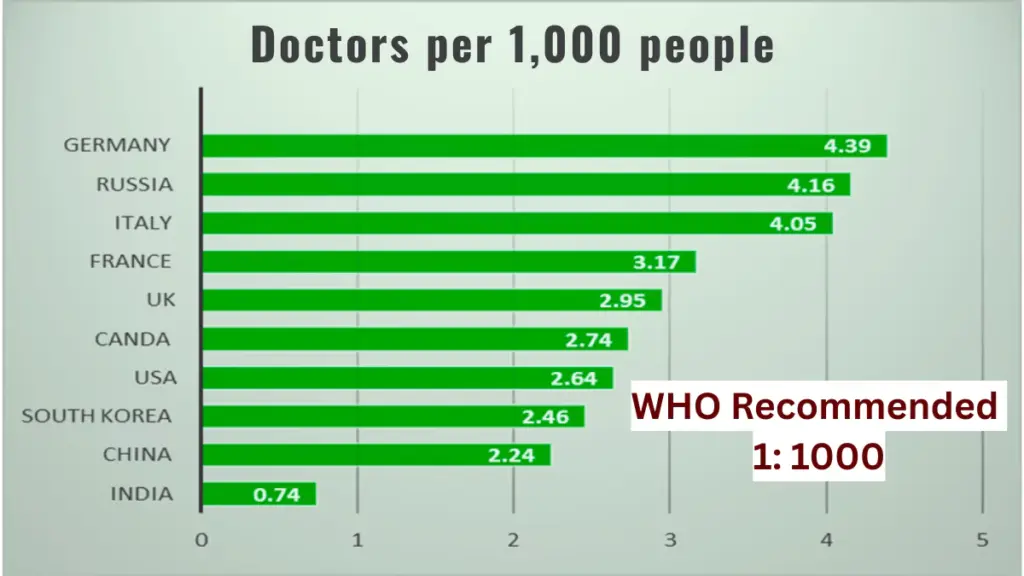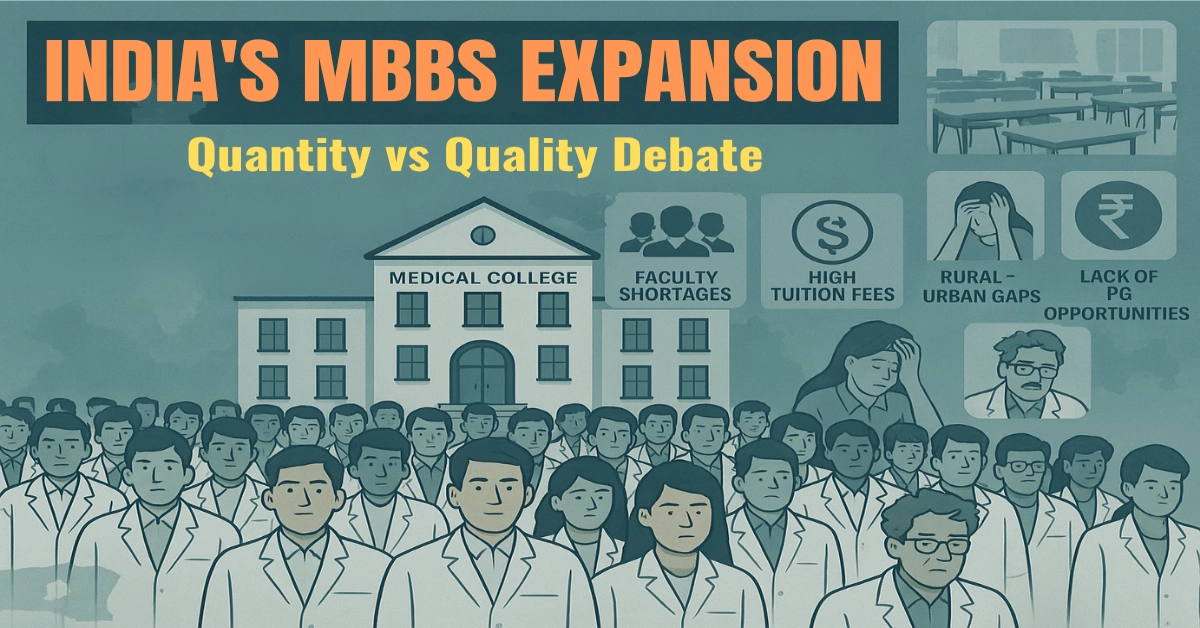NMC MBBS Expansion 2025: India now has 808 medical colleges and 123,700 MBBS seats, positioning itself as a global leader in medical education. While these figures suggest significant progress, they overshadow the persistent challenges plaguing the nation’s medical education system. The rapid expansion, driven by the Centrally Sponsored Scheme (CSS) Phases 1-3, raises critical questions about the quality and sustainability of this growth.
| Despite a record 123,700 MBBS seats, the shortage of specialists, proper clinical training, and postgraduate opportunities threatens the effectiveness of India’s healthcare system. |
NMC MBBS Expansion 2025: Quality vs Quantity
Despite the rise in medical colleges, the quality of education remains a big concern. A significant factor contributing to this issue is the acute shortage of qualified faculty members.
For instance, approximately 40% of medical faculty positions remain vacant in AIIMS, with some departments experiencing up to 80% vacancies.
This shortage hampers the delivery of quality education and affects the overall learning experience of medical students.
“Quality assurance in medical education involves putting in place policies, standards, systems, and processes to maintain and enhance the quality of medical education at all levels and stages.” – World Health Organisation (WHO) on Medical Education Quality
Read Also: AIIMS Faculty Shortage Crisis: Causes, Impact, and Solutions
Moreover, the National Medical Commission’s (NMC) recent policy changes have allowed MSc and PhD holders to occupy up to 30% of faculty positions in certain subjects. While this aims to address faculty shortages, it raises concerns about the depth of subject expertise and the potential compromise on teaching quality.
In his 2012 editorial, Quality assurance in medical education (Indian Journal of Pharmacology, 44(3), 285–287), Dr M. A. Joshi underscores the critical importance of quality assurance in medical education, arguing that it is fundamental to shaping competent and ethical medical practitioners.
He highlights that the concept of quality in education is subjective, requiring continuous evaluation and improvement of teaching and learning processes.
Dr Joshi further emphasises the vital role of stakeholder involvement, including students, faculty, and healthcare professionals, in developing and implementing effective quality assurance mechanisms.
His insights suggest that merely increasing the number of medical seats without ensuring rigorous quality standards may compromise the competency of future doctors, ultimately affecting the overall healthcare system in India.
Medical Education: Access for the Wealthy, Not the Needy
The expansion of private medical colleges has inadvertently created a divide in access to medical education. With escalating fees, these institutions have become increasingly unaffordable for the average student. This trend is evident in the rising costs of MBBS programs, which are out of reach for many aspiring medical professionals.
NMC Act 2019, through Section 10(1)(i), explicitly focuses on the implementation of NMC Fee Guidelines, but private colleges are resisting it. It resulted in the clash between NMC fee guidelines and private college charges.
| Opening more private medical colleges only benefits wealthy students, leaving middle- and lower-income aspirants struggling for affordable, quality education. Medical education is being treated as a business, not a public health necessity. |
Consequently, medical education is becoming a privilege for the affluent, sidelining talented students from economically disadvantaged backgrounds. This growing disparity threatens the equitable distribution of healthcare professionals across the country.
As a result, middle-class NEET aspirants look beyond borders for the MBBS Abroad program in countries like Russia, Georgia, Kyrgyzstan, etc.
In his Independence Day Speech on August 15, 2024, from the Red Fort, PM Narendra Modi highlighted the trend of middle-class students going abroad for medical education. He stated: “Around 25,000 youths every year go abroad for medical education… we have decided that in the next five years, we will create 75,000 new medical seats.”
This announcement aimed to reduce the necessity for students to study abroad by increasing the availability of medical seats within India.
Read Also: Monopoly in Medical Education in India: Ownership, Costs & Reforms 2025
Specialist Shortages Remain Critical
While the number of medical graduates has increased, the country faces a severe shortage of specialists. The doctor-to-population ratio in India remains below the World Health Organisation’s recommended standards, with significant disparities between urban and rural areas.

| Even with increasing seats, most MBBS graduates remain unemployed or forced into high-cost postgraduate programs due to limited PG seats and specialisation opportunities, further exacerbating the crisis. |
The expansion of medical colleges has not been accompanied by a proportional increase in postgraduate training opportunities. This imbalance results in a bottleneck, where numerous MBBS graduates are unable to pursue specialisation due to limited PG seats and high competition.
To address this issue, recently NMC chairman Proposed AI integration and 1:1 MBBS-PG seat ratio for medical education.
Infrastructure Gaps in Smaller Towns
The focus of medical college expansion has predominantly been in urban centers, leaving smaller towns underserved. This urban-centric development exacerbates the rural-urban healthcare divide, with many smaller towns lacking adequate medical facilities and professionals.
Time and time again, India’s public health system has failed the poor, costing them their fortune and lives.
| Rural and tier-2/tier-3 towns continue to observe a huge gap in medical education and the healthcare system. Urban areas see most of the expansion, while tier-2, tier-3, and rural towns continue to suffer from severe shortages of doctors and hospitals. |
Without targeted efforts to establish medical colleges and healthcare infrastructure in these areas, the goal of equitable healthcare access for all citizens remains elusive.
Read Also: India’s Medical Education Revolution: NMC Reforms, CBME, NEXT & More
Healthcare System Requires Holistic Reform
Addressing the challenges in Medical Education in India with MBBS seat expansion and modern technology integration necessitates a comprehensive approach.
This includes increasing government budgets for medical training, enhancing faculty development programs, and improving infrastructure in underserved areas.
| Without comprehensive reforms in nursing, medical technicians, hospital management, and allied health education, India cannot achieve equitable and quality healthcare. |
Additionally, implementing compulsory health insurance with government subsidies for the underprivileged can ensure broader access to healthcare services.
Merely increasing the number of medical seats without addressing these systemic issues will not lead to meaningful improvements in healthcare delivery.
The Danger of Overexpansion Without Oversight
The rapid expansion of medical colleges, without stringent regulatory oversight, poses risks to the quality of medical education. Instances of substandard institutions and inadequate facilities highlight the need for rigorous accreditation processes and continuous monitoring.
| Expanding medical colleges without proper oversight, infrastructure, and teacher training may result in a generation of doctors who are academically qualified but clinically underprepared. |
Ensuring that new medical colleges meet established standards is crucial to prevent the proliferation of subpar education and maintain the integrity of the medical profession.
“The Medical Institutions (Qualifications of Faculty) Regulations, 2025 will directly support the national goal of expanding access to quality medical education.” – NMC on Faculty Qualifications
Read Also: NMC Medical College Faculty Rule 2025: Know Who Will Teach You MBBS!
Quality First, Numbers Later
While the expansion of medical colleges and MBBS seats is a step towards addressing the healthcare workforce shortage, it is imperative to prioritise quality over quantity.
The government must ensure quality oversight before approving more seats. India must aim for world-class training, not just world-class numbers.
| Dr A. Shaji George & Dr T. Baskar (2025) In their comprehensive analysis, they highlight that India is at a critical juncture in its healthcare evolution. They question whether an MBBS degree will maintain its traditional value amid shifting demographics and increasing practitioner numbers. Their findings suggest that the value of an MBBS degree will increasingly depend on specialisation, geographic flexibility, adaptability to technological change, and willingness to explore non-traditional career pathways. These factors are crucial for prospective medical students to consider before committing to this demanding educational journey. – A Critical Analysis of India’s Medical Workforce Projections and the Future Value of MBBS Education. |
Investing in faculty development, infrastructure, and equitable access to education will yield more sustainable and impactful results. Only through a balanced approach can India achieve its goal of providing world-class medical care to all its citizens.


